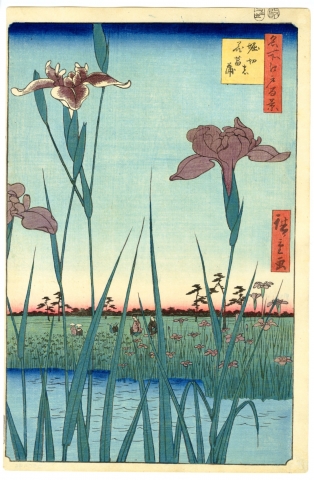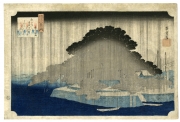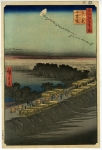 Hiroshige One Hundred Famous Views of Edo, The Irises in Horikiri
Hiroshige One Hundred Famous Views of Edo, The Irises in Horikiri

|
| Item No | A1-90-387 |
|---|---|
| Series | One-hundred-Famous-Views-of-Edo |
| Title | One Hundred Famous Views of Edo, The Irises in Horikiri |
| Artist | Hiroshige |
| Date | 1857 |
| Condition | Very good Trimmed |
| Impression |
Warning: Use of undefined constant - assumed ' ' (this will throw an Error in a future version of PHP) in /home/httpd/japanese-finearts.com/public_html/item/main_height.inc on line 211 Very good |
| Size | 24×35.5cm |
| Price | SOLD |
| Tag |
|---|
With the iris depicted in the foreground, people admiring the flowers are set behind in the lower part to be peeped between the flowers, that gives the screen a perspective. The iris in Horiki is one of the famous spots to visit in Edo, so that famous artists like Hiroshige , Utagawa Toyokuni and Kiyochika have depicted. In each May, people enjoyed the iris colored in lazuline, snow white or navy blue. The closeup iris is so impressive.
Hiroshige
1797-1858
Ukiyoe painter. Also referred to as Ichiyusai, Ichiyosai, Utashige, and others. A pupil of Toyohiro. He started his career as working on the illustration for Kyoka (=comic Tanka poem) book or the actor painting. In 1832, he went up to the capital accompanying the Bakufu's procession, where being inspired so much, he produced and published, in the following year, " Fifty-Three Stations of the Tokaido " based on his experience on the journey. Its success boosted him to become a landscape painter. Afterwards, he successively sent out the masterpiece to the world such as "Famous Views of the Various Provinces" and “Famous Views of Edo". Other representative pieces are "Famous Views of the Eastern Capital", " One Hundred Famous Views of Edo ", and so on.
One-hundred-Famous-Views-of-Edo
"The Hundred Famous Views of Edo" is Hiroshige 's latest years' work produced over from 1856 to 1858. His creation continued just before his death, but it hadn't completed and handed down to Hiroshige II who added some brush strokes to issue the work. The work comprises the contents and 118 pieces of drawings.








